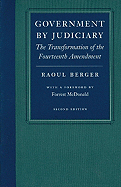How should the Constitution be interpreted? What context should be considered, if at all? And if the Constitution should be interpreted as it was originally conceived, how does one go about determining what the Founders meant?
In a review of Originalism and the Good Constitution by John O. McGinnis and Michael B. Rappaport*, Kurt T. Lash at the University of Illinois College of Law examines the rather complicated matter, highlighting the strengths and flaws in their argument.
Lash defines originalism in the context of the review as a “reformist movement in contemporary American constitutional law” whose proponents “reject modern interpretive theories such as ‘living constitutionalism’ and call for the restoration of the foundational understanding of the text.”
The next question, of course, is how one goes about understanding the text, and within the originalism movement, according to Lash, there are two separate approaches. In their book, McGinnis and Rappaport advocated for what Lash calls “methodist originalism” as opposed to “constructionist originalism.”
The logic of constructionist originalism, Lash says, is as follows
Since judges are not always able to fully determine the original meaning of a text or discern exactly how it ought to be applied to a particular legal dispute, they must often fill the gap between original meaning and current application by using a judicially constructed rule of interpretation. According to this approach, the less we know about original meaning, the more room exists for judges to fill the space with non-originalist judicial doctrine” (emphasis added).
“Unlike constructionist theories,” Lash writes, “which allow for non-originalist construction of underdetermined texts, methodist originalism proposes filling in the historical gaps with what McGinnis and Rappaport claim were the originally accepted methods of interpretation. This is originalism all the way down” (emphasis added).
Proponents of this version of originalism argue that the benefits of supermajoritarian decision-making make it a preferable way of determining the meaning of the Constitution. As they see it, judges “must apply the text exclusively through the use of interpretive methods in play at the time of the Founding,” according to Lash (emphasis added).
As in other papers, the authors believe that supermajoritarian voting procedures ensures “broad public acceptance of norms intended to remain in place for generations,” according to Lash.
In one section of their book, the authors argue the following:
The constitutional enactors voted to ratify the document based on their understanding of the text and how they believed it would be interpreted by subsequent generations. Thus, modern courts should interpret the Constitution using the same interpretive methods that the enactors would have used—a process we call original methods originalism (emphasis added).
But again, this begs the question. How does one go about determining this?
Their inability to answer the question, as Lash sees it, is a fatal flaw in their version of originalism.
“..to succeed, they must prove the existence of supermajoritarian agreement on the interpretive method to be applied to each text of the Constitution,” he writes. “Anything less either fails the supermajoritarian requirement or leaves room for non-originalist construction. This is an enormous empirical burden and one that proves too great for McGinnis and Rappaport to carry.”
The reason for this, he writes, is that they must “show that a supermajority of the framers or ratifiers embraced one or more particular methods of interpretation for the particular texts of our particular Constitution. Absent such evidence, a judge’s choice of interpretive method will not be guided by supermajoritarian agreement, but by her normative theory of constitutional law. But this is precisely the kind of non-originalist normative choice that McGinnis and Rappaport reject” (emphasis added).
As an example of the dilemma in choosing interpretive methods, Lash cites the 11th Amendment and the debate over whether it stemmed from a misinterpretation of Article III or not. How did one decide either way?
“If we had clear evidence that a supermajority of the framers or ratifiers embraced one method over the other,” he writes, “then this would justify judicial application of that method. Unfortunately, we have nothing near this level of evidence from the extant historical materials. At most, we have broad agreement that states would retain their sovereign status following the adoption of the Constitution, and this might imply something like a “strict construction” approach to texts like Article III. But even this point remained under significant dispute for decades—indeed, to this very day” (emphasis added).
While Lash describes Originalism and the Good Constitution as an “excellent book,” he includes a curious critique at the end of his review:
What the authors fail to recognize, however, is that the proper methods of constitutional interpretation were not only under-resolved at the time of the Founding, they were the subject of heated and on-going debate. McGinnis and Rappaport have given us good reason to strive for supermajoritarian agreement whenever possible, and good reason to preserve that agreement until it is superseded by another ‘speaking of the people.’ Methodism cannot, however, give us agreement where none existed (emphasis added).
 “It is history itself that tells us that originalism cannot go all the way down,” he concludes.
“It is history itself that tells us that originalism cannot go all the way down,” he concludes.
One of the issues the Founders had to contend with, Lash points out, is that there had been no prior written constitution for them to base their methods of interpretation on, which forced them to come up with their own rules of interpretation.
However, according to Tom Woods, author of Nullification: How to Resist Federal Tyranny in the 21st Century, the Founders left us with a rather easy way to find out the text’s meaning.
James Madison urged that the true meaning of the Constitution was to be found in the state ratifying conventions, for it was there that the people, assembled in convention, were instructed with regard to what the new document meant. Jefferson spoke likewise: should you wish to know the meaning of the Constitution, consult the words of its friends” (emphasis added).
*The authors co-belief in supermajoritarty rule is also articulated in a separate paper titled “Our Supermajoritarian Constitution,” in which they argue that the Constitution is “governance through supermajority rules.”
SOURCE: Tenth Amendment Center – Read entire story here.





